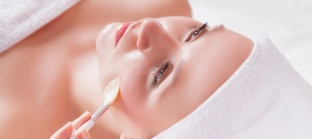Surface peeling – a procedure demanded by patients, which is offered by almost every cosmetology clinic or salon. Its popularity is due to the fact that the mechanism of the procedure, when dead cells are exfoliated and the skin is simulated for renewal, is intuitively clear to everyone. However, expectations from superficial peeling in patients may not correspond to reality, and the woman leaves the clinic upset, suspecting her beautician of unprofessionalism. How not to deceive the patient's expectations, and what to warn him about before the superficial peeling procedure, recommends estet-portal.com.
Features of chemical superficial peels and their effect
The superficial peeling procedure has been played a cruel joke by mass advertising, the essence of which is to present it as an easy, safe intervention that can be done during a lunch break. It is expected that upon completion of the peeling, a noticeable rejuvenating effect will appear on the face, and the procedure itself will be painless, fast, without negative consequences and traces that take time to heal.
In order for the patient not to be disappointed, it is necessary to tell in detail about the possibilities of superficial peeling, the process of the procedure and its expected results. Sometimes facts that are completely obvious to a doctor can be a real discovery for his patient.
The conversation about superficial peeling should start with the fact that this is a method of controlled skin damage, when the upper layers of the epidermis are removed and regeneration processes are activated. But the removal of the epidermis is not able to significantly reduce the depth of wrinkles
The patient must understand that superficial peeling – it's stressful for the skin. And the new rejuvenated skin for which she came to the procedure will not appear immediately, it will take time to form.
Superficial chemical peels are considered by experts to be quite safe and effective in order to achieve the following results:
- stimulate your own collagen production;
- improve skin texture, smooth it, achieve a healthy color;
- reduce the appearance of pigmentation;
- combat enlarged pores, hyperkeratosis;
- to soften the manifestations of photoaging;
- get rid of stagnant spots after acne, inflammatory elements;
- create conditions for regeneration of the stratum corneum and restoration of skin hydration.
The classic composition of surface peels usually includes alpha hydroxy acids, as well as retinoic, salicylic, trichloroacetic acids. Peeling with salicylic acid, in addition to being beneficial for problem skin, evens out the tone of dark-skinned patients well. Peelings based on mandelic acid inhibit the processes of melanogenesis and give a good lifting effect. The combination of malic, lactic and mandelic acids is used to smooth the microrelief and cleanse sensitive skin.

Importance of home care after superficial peeling
The patient must understand that the result of superficial peeling largely depends on him, and not only on the beautician. Of course, the doctor is responsible for the depth of damage and their intensity, for measures to accelerate skin regeneration, for the safety of the procedure and the prevention of infections. But skin care after exfoliation remains on the patient's conscience, and this stage is no less important than the procedure itself. The patient should receive detailed instructions:
- how to take care of the skin section after peeling and a few days later;
- which side effects are absolutely normal for the healing phase, and which ones you should be worried about and call the doctor;
- why it is absolutely impossible to tear off the dried crusts on the face;
- when you can use makeup and what kind.
For home care, the patient needs to choose ointments and creams with hyaluronic acid, antioxidant vitamins, milk proteins, which accelerate the regeneration processes. Supportive care – this is not a one-day event, the need for it may persist for several months after a course of peeling procedures.
Peels should not be abused and patients should be aware of this. Chemical damage, even if we are talking about the "lungs" from the point of view of women fruit acids, provokes the restoration of keratinized epithelium. If it is damaged regularly, the skin will roughen, but will not look younger in any way
After superficial peeling, it is necessary to explain to the patient how long and why it is necessary to refrain from other procedures associated with skin damage. It is recommended to offer cosmetic skin care programs that will support the result achieved by peelings.
Read also: Acid peeling: the anatomy of a chemical peel







Add a comment